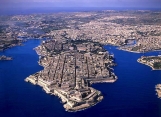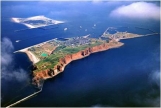Welcome
to the "Ecological Footprint of Islands"!
Here you can calculate the Ecological
Footprint for your island.
The
earth has a limited biocapacity which is already being exceeded by
human exploitation. Currently more resources are extracted than can be
renewed by the natural system (measured within one year) and humanity’s
imprint on the earth’s ecosystem becomes more and more visible. We need
strategies to reverse this process and live more sustainably on our
planet!
The Ecological Footprint calculator for islands is part of the research
project "The Ecological Footprint – A standardised tool for small
island sustainability promotion on the basis of the Ecological
Footprint methodology" by Prof. Dr. Ratter and Jan Petzold at the
Institute of Geography, Hamburg University. We intend to develop an
applicable version of the Ecological Footprint concept for a
cross-island survey about sustainability.
The next section explains the theoretical background of the Ecological
Footprint concept. Further down you can get to the calculation form,
where you can calculate your island's Ecological Footprint. The results
of the calculation will be displayed immediately, saved and used within
the thesis project. If you wish you can be informed about the final
result of the project.
Please read the explanations on this page as well as on the calculation
page carefully before calculating your island's footprint.
What
is the Ecological Footprint?

The Ecological Footprint is a concept developed by William Rees and
Mathis
Wackernagel in 1994 to illustrate the ecological overshoot of
particular groups
of people, from the individual to the nation-state and the world. The
Ecological Footprint
measures flows of energy and matter to, from and within a society in
order to
account how much productive land and sea area is necessary to supply
all goods
and degrade waste for that specific society. The result is a footprint of the
society on the earth, measured in so called global hectares.
The concept is used to foster and promote the
understanding of our earth‘s limited resources and need to change towards
a sustainable life style. An Ecological Footprint Assessment can
work as a
support tool for policy-makers in order to encourage and develop
strategies
towards a more environmentally responsible life-style. Originally an
educational tool, the Ecological Footprint concept has reached broad
application in governmental
assessments and regional planning. Additionally, it is useful
commercially and
on company level. The weakness of the concept, however, is that it is
assessing
solely the state of a society to date, lacking future suggestions of
improvement. Thus, the actual Ecological Footprint result alone is not
very powerful and besides
very complicated to calculate.
Islands, particularly small islands,
face
certain circumstances that distinguish them from continental
regions and make
them interesting for the Ecological Footprint: natural boundaries of
islands intensify the
pressure of limited space available for production. Thus, imported and
exported
goods have to be transported via sea or air, while infrastructural
connections
to the mainland traffic networks or power grids are hardly possible.
These
circumstances have consequences for the Ecological Footprint. For
instance, less car traffic
could lead to a lower carbon footprint; higher air and seaway traffic
for
transportation could contrariwise increase the impact. Also, other
island
specific characteristics such as a major role of the fishing industry
and
consumption need closer consideration.
Calculate
your Island's Ecological Footprint
We
invite you to participate in our project by collecting data and
using our footprint calculator. First of all, to complete the

calculation form for your island's
Ecological Footprint, you will probably need data that is not
immediately available. Try different sources, official statistics,
published surveys or try to estimate the required data. The
following will briefly explain the questionnaire and the
thoughts behind the respective
questions.

The
calculation of the Ecological
Footprint is based on the idea of
measuring
human consumption of resources
and the according land area needed for production.
The general consumption categories are nourishment, shelter, transport
and
waste. For these categories, land use of cropland, grazing land,
forest and built-up land are calculated.

We use
the standard units
and calculation
methodology suggested by the Global Footprint Network for this project.
Furthermore, a selection of the most important footprint categories
with respect to data availability were chosen in order to allow a
rather general/universal survey including various parties. Depending on
the depth of an
Ecological Footprint Assessment, the consumption categories can be
subdivided as far as you want. This, however, goes along with further
complexity of the calculation process and especially problems in data
availability.
Case
study Helgoland

In
2008 we already tried to apply the Ecological Footprint concept
on the German island Helgoland. On this basis we were able to connect
the concept to the particular situation of a small island (for German
speakers:
www.fussabdruck-helgoland.de).
The problem of
data availabilty
also came up during our project on Helgoland. For this reason data had
to be collected from various sources. Data on food products for example
from the harbour authority, which let us access the official statistics
for import and export. Data on power consumption was available from the
local power plant, which produces all the energy consumed on the
island.
Since
there is no car travel on Helgoland, the only relevant transportation
mode was by boat/ship. For this we got data from the harbour service
station.
In
general, however, passenger transportation is rather difficult to
measure. There are various approaches to account for the emissions set
free by the different modes of travelling. This survey uses the
approach of passenger kilometres. By trying to estimate how many
kilometres people travel on the island per year, it is possible to
calculate the emissions generated approximately. Certainly, this cannot
be more than an estimate, but for the purpose of this study it is the
most
applicable solution for the transportation category.
The last
section includes a selection of materials: paper, textiles, aluminium,
other metals, plastic and wood. Data for this category is often found
at
disposal and landfill sites, if there are available statistics.
Otherwise, again harbour statistics are always a good option
for islands.
Your
island's footprint calculation
Please
do not
hesitate to insert estimates in the form, if official data is not
available. Let us know what kind of data you entered by the drop-down
menu.
The
generalisation applied in this methodology due to the objective of
broad applicability, however,
decreases the precision and explanatory power of the single result.
Thus, the result should not to be considered as precise
analysis of local sustainability but rather as step to achieve a
comparable overview on global island sustainability.
As this is just a
first step within a project there may be further work to be done
subsequently on the basis of the networking and results generated by this project. The more islands
participate in this project the more
powerful will be the results and benefit for the island community!
Please participate!


 calculation form for your island's
Ecological Footprint, you will probably need data that is not
immediately available. Try different sources, official statistics,
published surveys or try to estimate the required data. The
following will briefly explain the questionnaire and the
thoughts behind the respective
questions.
calculation form for your island's
Ecological Footprint, you will probably need data that is not
immediately available. Try different sources, official statistics,
published surveys or try to estimate the required data. The
following will briefly explain the questionnaire and the
thoughts behind the respective
questions. The
calculation of the Ecological
Footprint is based on the idea of measuring
human consumption of resources
and the according land area needed for production.
The general consumption categories are nourishment, shelter, transport
and
waste. For these categories, land use of cropland, grazing land,
forest and built-up land are calculated.
The
calculation of the Ecological
Footprint is based on the idea of measuring
human consumption of resources
and the according land area needed for production.
The general consumption categories are nourishment, shelter, transport
and
waste. For these categories, land use of cropland, grazing land,
forest and built-up land are calculated.  We use
the standard units
and calculation
methodology suggested by the Global Footprint Network for this project.
Furthermore, a selection of the most important footprint categories
with respect to data availability were chosen in order to allow a
rather general/universal survey including various parties. Depending on
the depth of an
Ecological Footprint Assessment, the consumption categories can be
subdivided as far as you want. This, however, goes along with further
complexity of the calculation process and especially problems in data
availability.
We use
the standard units
and calculation
methodology suggested by the Global Footprint Network for this project.
Furthermore, a selection of the most important footprint categories
with respect to data availability were chosen in order to allow a
rather general/universal survey including various parties. Depending on
the depth of an
Ecological Footprint Assessment, the consumption categories can be
subdivided as far as you want. This, however, goes along with further
complexity of the calculation process and especially problems in data
availability. In
2008 we already tried to apply the Ecological Footprint concept
on the German island Helgoland. On this basis we were able to connect
the concept to the particular situation of a small island (for German
speakers: www.fussabdruck-helgoland.de).
In
2008 we already tried to apply the Ecological Footprint concept
on the German island Helgoland. On this basis we were able to connect
the concept to the particular situation of a small island (for German
speakers: www.fussabdruck-helgoland.de).